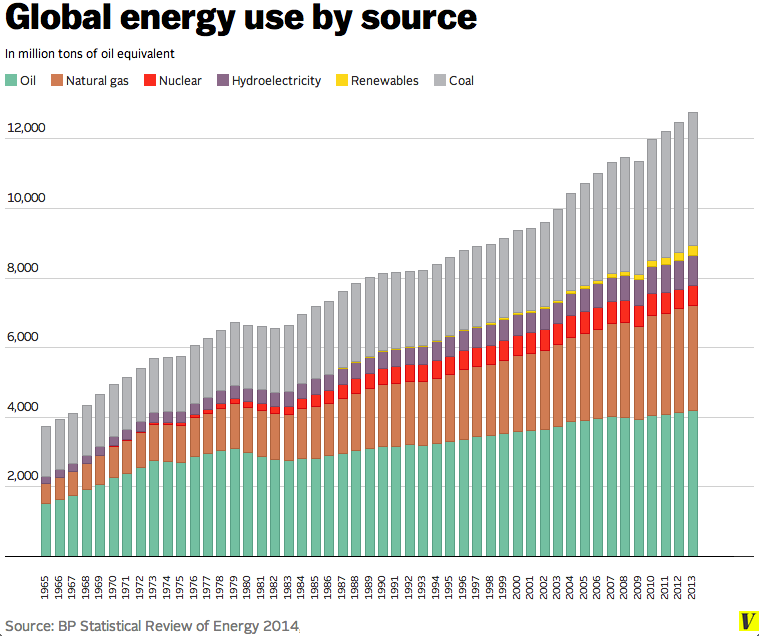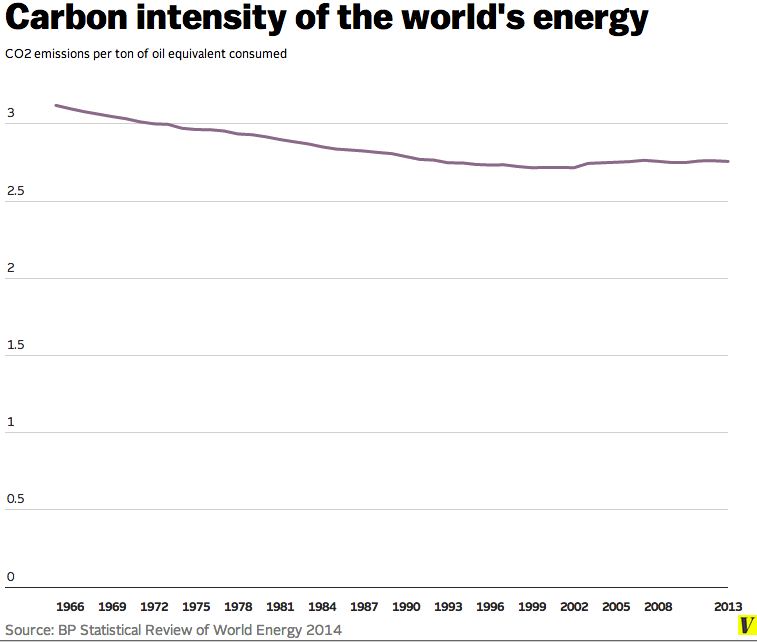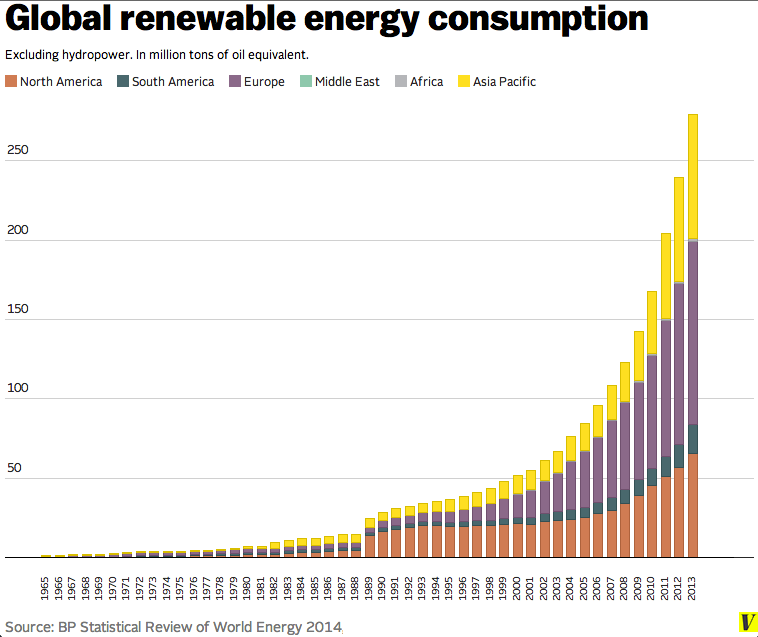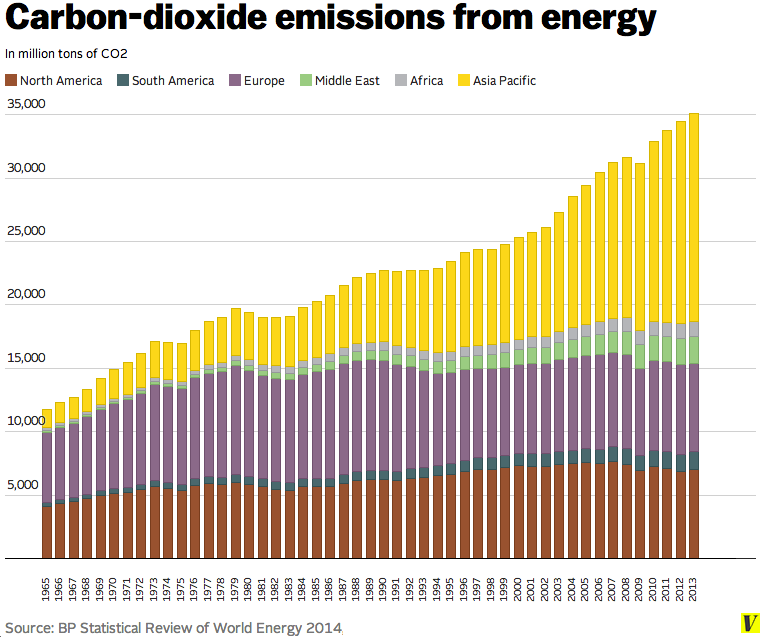Maesurables
It's getting better all the time
- The Beatles
Ooops, I did it again
-Brittney Spears
Greetings
Mark K likes to say that you can't change what you can't measure. Here's our report card.
I'd like to say its a mixed bag, but .. More coal, more renewables, but even more fossil fuels. To me the most telling to me is the "carbon intensity". The only way we can "have our cake and eat it too" is to get more energy with less carbon. That's not really happening. See below .
How about a "turning point" ? Maybe things are getting worse, but not as fast as they used to be? I took a look at Mauna Loa. They have a nice chart showing the CO2 trends. While it seemed to slow a little in the 1990's, since then growth in CO2 has increased pretty steadily, Last year it was see here
How about on the other end? Thanks to Ecoshock radio, I recently stumbled across David Spratt's analysis of the "carbon budget". Spratt, ,the author of Climate Code Red, argues that the climate budget is set too high, because it only gives us a 60% chance of staying under 2 degrees. Would we get in a car, or plane, if we knew we had a 40% chance of an accident? He argues that if we set the limit at 90% would make more sense. But using that probability, we would have already used up our carbon budget. see here Spratt's suggestion:
We now have a choice to make: accept much higher levels of warming of 3–5°C that will destroy most species, most people and most of the world's ecosystems; a set of impacts some more forthright scientists say are incompatible with the maintenance of human civilisation.Or we can conceive of a safe-climate emergency-action approach which would aim to reduce global warming back to the range of conditions experienced during the last 10,000 years, the period of human civilisation and fixed settlement. This would involve fast and large emissions reduction through radical energy demand reductions, whilst a vast scaling-up of clean energy production was organised, together with the remaking of many of our essential systems such as transport and food production, with the target being zero net emissions. In addition, there would need to be a major commitment to atmospheric carbon dioxide drawdown measures. This would need to be done at a speed and scale more akin to the "war economy", where social and economic priority is given to what is perceived to be an overwhelming existential threat.
------------------
There's a fair bit of optimism in green circles that fossil fuels are dying and renewables like wind and solar are set to take over. Al Gore has a hopeful new essay in Rolling Stone along these lines, arguing that "a powerful, largely unnoticed shift is taking place."
IN 2013, FOSSIL FUELS PROVIDED 87% OF THE WORLD'S ENERGY — THAT HASN'T CHANGED SINCE 1999
One problem? It's hard to see this shift in the numbers — at least so far. Yes, solar panels are getting cheaperand coal is on the wane in the United States. But the growth of fossil fuels in Asia is still swamping those clean-energy trends. The result: more carbon-dioxide emissions and more global warming.
Here's a simple way to see this: In 2013, coal, oil, and natural gas provided 87 percent of the world's energy. That fraction hasn't changed since 1999. The world has basically made zero progress in moving away from fossil fuels over the last 15 years. If we want to slow the pace of climate change, that has to shift very drastically.
Those numbers come from BP's new Statistical Review of World Energy 2014, which is worth a careful read for anyone interested in the global energy system. I've put some of their data in chart form to tell the story below:
1) Clean energy is growing worldwide. But fossil fuels have grown even faster.

As the world grows, it keeps using more and more energy. And fossil fuels still supply the vast majority of that energy. Oil remains the dominant source of fuel for our cars, trucks, and airplanes. And coal and natural gas are the leading sources of electricity.
THE WORLD ADDED TWICE AS MUCH COAL LAST YEAR AS RENEWABLE ENERGY
All told, fossil fuels made up 87 percent of the world's energy consumption in 2013. By contrast, low-carbon sources — including nuclear, hydropower, wind, solar, and biomass — made up just 13 percent.
That ratio hasn't changed since 1999, as the University of Colorado's Roger Pielke Jr. points out.
So, yes, clean energy sources have been rising over time. That little yellow sliver showing renewable energy is growing at rapid clip. But coal, natural gas, and oil have more than kept pace.
One illustrative example: over the last year, renewable energy grew by 38.5 TOE (tons of oil equivalent). But coal grew by 103 TOE, more than twice as much.
2) The world's energy system hasn't gotten any cleaner since 1999

Here's another way to view the same trend. The chart above shows the amount of carbon-dioxide the world generates for every unit of energy it consumes. This is "carbon intensity," and it's a good way to measure how "clean" the world's energy system is.
IF WE WANT TO TACKLE CLIMATE CHANGE, CARBON INTENSITY HAS TO DROP — A LOT
For decades, the world was making gradual progress here: In 1966, the world emitted 3.1 tons of carbon-dioxide for every unit of energy it consumed. By 1999, that had declined to 2.71 tons.
But then progress halted — particularly as China went on a massive coal-fueled growth binge. By 2013, the carbon intensity of the world's energy had actually risen to 2.76 tons of carbon dioxide per unit of energy.
If the world wants to seriously tackle global warming, then it's not enough to have a bit of progress in clean energy here or there. Instead, the carbon intensity figure in the chart has to drop very, very, very drastically. That's especially true given that the world is likely to keep consuming more and more energy as it gets richer.
Over at his site, Pielke runs some rough numbers on this. If humanity wanted to boost its energy use by 50 percent and cut carbon-dioxide emissions by 50 percent, then the carbon intensity of energy would need to fall to one-third of what it is today.
In other words, the entire world's carbon intensity would have to fall from 2.76 tons of CO2 per unit of energy down to 0.9 tons or so. That's a notch below the carbon intensity of Norway (0.99 tons). Basically everyone would have to copy Norway.
That's a tough task — especially since we seem to be going in the opposite direction:
3) The world is using more coal than ever before

Burning coal for electricity is the leading source of carbon-dioxide emissions — and coal use keeps growing rapidly. Back in the 1980s, coal supplied just 10 percent of the world's energy. Now it supplies about 30 percent.
CHINA NOW CONSUMES 50% OF THE WORLD'S COAL
There are regional variations here. Coal use has actually declined in North America and Europe since the late 1980s, as countries have shifted to natural gas and other cleaner sources of electricity.
But at the same time, coal use skyrocketed in Asia, which is growing fast and is now responsible for 70 percent of coal consumption. (China alone is responsible for a little over 50 percent.)
True, this may not last forever. Lately there have been some signs that China's coal habit will quit growing in the years ahead. But most of China's coal plants are still relatively young, which means they can operate for decades to come. It's difficult to envision that China's coal use will decline significantly anytime soon.
4) Renewable power is surging, but it's still relatively small

Now, it is true that clean energy is on the rise. The chart above shows all renewables apart from hydropower: so that includes biomass, biofuels, geothermal, wind, and solar. And there's a clear acceleration in recent years.
BIOFUELS AND BIOMASS STILL DOMINATE AMONG RENEWABLES
Wind and solar are growing especially fast. They provided 3.2 percent of the world's electricity in 2013, and accounted for 27 percent of the growth in electricity generation.
But renewable energy is still a small part of the global energy mix. In 2013, renewables around the world provided just one-tenth of the energy that natural gas did. Growth in renewables will need to accelerate in the future to shake the dominance of fossil fuels.
(By the way, most renewables are actually biofuels and biomass, as Robert Wilson explains at The Energy Collective. That's a key caveat, since there are good arguments that burning wood for electricity or converting corn into ethanol isn't all that environmentally friendly.)
5) As a result, global carbon-dioxide emissions keep rising

And as fossil fuels expand, so do global carbon-dioxide emissions, which rose 2.1 percent between 2012 and 2013 — a rapid clip even during a period of relatively slow economic growth.
HALF THE WORLD'S EMISSIONS NOW COME FROM ASIA
There are regional variations here: Emissions from energy use in the United States and Europe have actually fallen over the past decade.
But, again, Asia is a different story. Nearly half (46.7 percent) of the world's emissions now come from the Asia Pacific region, with 27.1 percent of emissions coming from China alone. And those emissions keep going up and up.
If that continues, the world can expect significant temperature increases and climate change in the decades ahead. The only way to avoid that is to make a fundamental shift away from fossil fuels and toward cleaner sources of energy. And in the last decade, at least, that shift has barely been noticeable on the global level.
Labels: Brad Plummer, Cliamte Code Red, Climate; Spratt, ecoshock radio


0 Comments:
Post a Comment
Subscribe to Post Comments [Atom]
<< Home